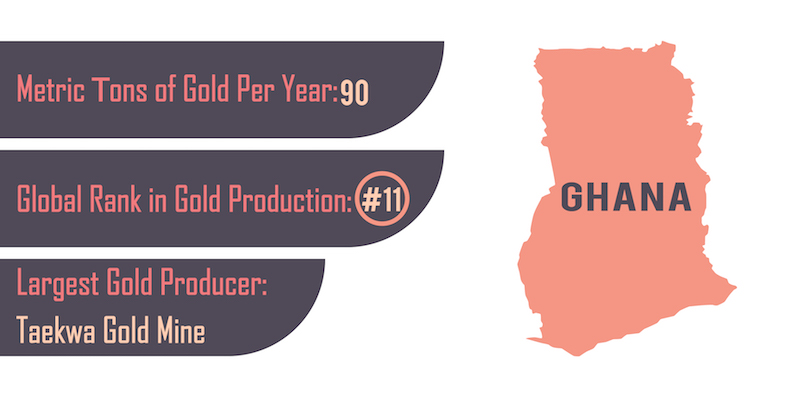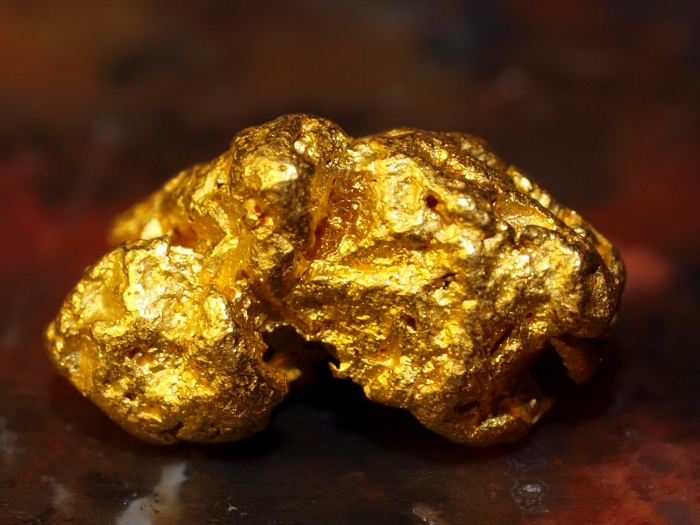
For some time, Ghana has been considered to be one of the world’s most plentiful regions for gold discovery. Located in West Africa, Ghana is the second largest gold producer on the African continent, and only South Africa stands ahead of them when it comes to gold production.
Ghana actually has a lengthy history in terms of gold mining. Dating back as early as the tenth century, gold from West Africa was regularly traded with Europe – reaching an estimated total of around a quarter of a million ounces per year. However, it wasn’t until the latter part of the 19th century that modern mining practices began to be used.
Historical Gold Mining Regions
Tarkwa was said to be one of the locations which held the most potential, so between the years of 1876 and 1882, Pierre Bonnat, the Gold Coast father of modern gold mining, began to develop the Precambrian auriferous conglomerates within this area.
A few years down the line in 1895, Ashanti Goldfield Corporation began mining in an area of Ghana called the Obuasi district. In the years proceeding this, the Ashanti and many other mines were developed substantially. So much so, that each of the mines combined actually produced the largest amount of gold deposits on the Gold Coast since the beginning of the 20th century.
For example, the Obuasi produced in excess of 25 million ounces of gold over the years, while Bogoso was able to produce more than 9 million ounces – taking their gold mining operations underground in order to achieve the majority of this.
In the modern era, the increased gold discoveries even places Ghana above Peru and Papua New Guinea in terms of estimated reserves. So, even though Ghana isn’t the first country that springs to mind when it comes to gold mining, this goes to show that it holds great potential and will likely see a lot of interest in years to come.
Gold mining has been crucial for the economic development of Ghana ever since the colonial period. This continues to be the case even in the 21st century, with both the mining sectors and cocoa sector having an equal importance in terms of their contribution to GDP growth.

Modern Mining in Ghana
Back in 2016, a 40-year high was reached when a total of 4.13 million ounces of gold were produced in Ghana. In turn, this produced a high amount of revenue which was surpassed even further just a year later in 2017, when annual gold revenues grew by 10.2% on the previous year. This was hardly surprising considering the impressive amount of gold which has been produced in the country – with output having increased substantially over the past few years.
The GDP of Ghana has also increased considerably in recent years, and the mining industry accounts for 5% of this. There is a total of 23 large-scale mining companies in Ghana, although these are not entirely dedicated to gold production alone – Ghana also produces diamonds and manganese too.

The Largest Mines
Southern Ghana is said to be the destination with the most gold mining potential in the country. This is where one of Ghana’s largest gold mines is located. This is based in Tarkwa – a major center for gold and manganese mining. This mine is run by Gold Fields Ghana, along with Damang – another of Ghana’s large gold mines. These two gold mines combined produced a total of 710,000 ounces of gold in 2017, meaning they are both fundamental to the gold mining industry in Ghana. However, this has since increased further a total of around 935,000 ounces annually.
Both the Damang and Tarkwa mines require a large number of staff to run them efficiently. In total, Gold Fields employs around 5,612 Ghanaians, and so this emphasises the importance of the mining industry in terms of its contribution both to the economy of Ghana as well as employment levels.
AngloGold Ashanti and Asanko Gold are two other substantial mining companies which operate gold mining in Ghana. These two companies combined have produced a large amount of gold within the country ever since they began operating there. Asanko Gold began commercial production back in April 2016 at the Asanko gold mine. AngloGold Ashanti on the other hand owns Iduapriem and Obuasi – two large gold operations within Ghana. In 2017 alone, Iduapriem was able to produce a whopping 228,000 ounces of gold – emphasising the scale of production in this particular gold mine.
Newmont Mining is another large mining corporation which operates in Ghana. This particular company runs two mines which produce gold – Ahafo and Akyem. Newmont Mining is actually well-renowned around the world for its sustainability when conducting their mining exploits.
There are a handful of other mining companies operating within Ghana too. This includes Golden Star Resources and Kinross Gold Corporation. The former is a mid-tier Canadian Gold Mining company which runs the Wassa and Prestea mines – both located on the Ashanti Gold Belt in Ghana. Combined, these mines are expected to produce around 280,000 ounces per year by the year 2021.
Wassa is the largest of the two mines, with between 120,000-135,000 ounces the reported production in 2016. Prestea on the other hand produced between 60,000-70,000 ounces in the same year. So, given the scale of mining taking place within each of the Golden Star mines, they appear to be well on track to achieving or even exceeding their output goal over the coming years.
In terms of Kinross Gold Corporation’s productions in Ghana, they run open pit and underground ore mining at the Chirano plant. This is located in Western Ghana within the Bibiani gold belt. In 2012, this particular mine was said to have produced around 263,911 ounces of gold.
Also Read: The Best Gold Nugget Metal Detectors
Artisanal Small-Scale Miners in Ghana
Ghana has received a lot of negative attention due to unregulated mining activity. This is much the same with the rest of Africa and in underdeveloped countries throughout the world for that matter.
This type of mining has minimal impact on the total gold output of the country, but it does have negative impacts on the environment, particularly due to sedimentation and mercury that contaminates the waterways. This is something that needs to be addressed more seriously by the Ghanian government, but the massive scale of these small mines throughout the country present a real challenge.
Future Potential
Should the overall gold production continue to grow at its current rate, Ghana will most definitely have the potential to further establish themselves as big time players in the mining industry. Political stability will go a long way in further advancing the activity within Ghana.
As a country with huge estimated gold reserves and high potential, there is no doubt that mining will play a critical role in the future development of the country.
Next: 9 African Countries with the Richest Gold Mines
